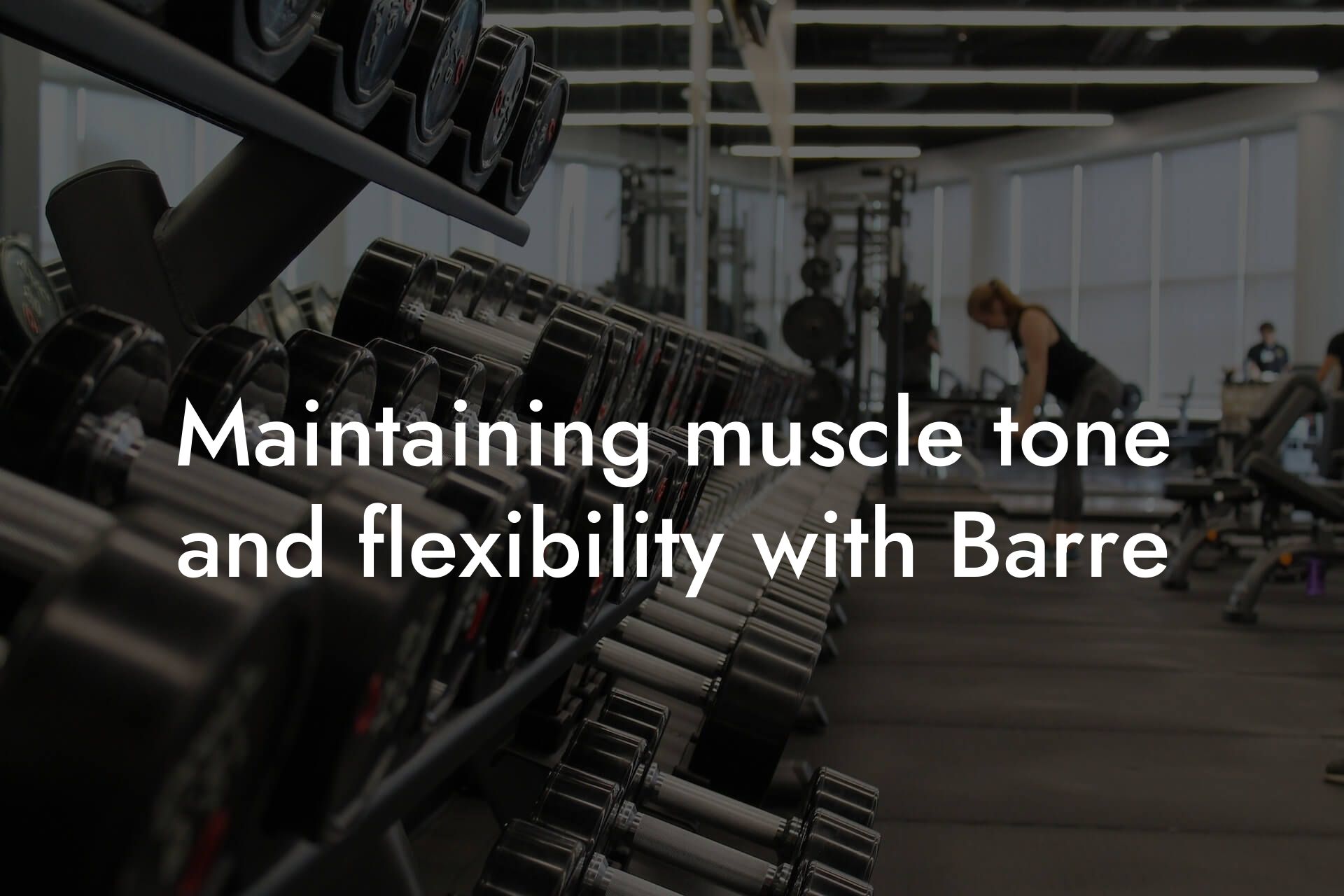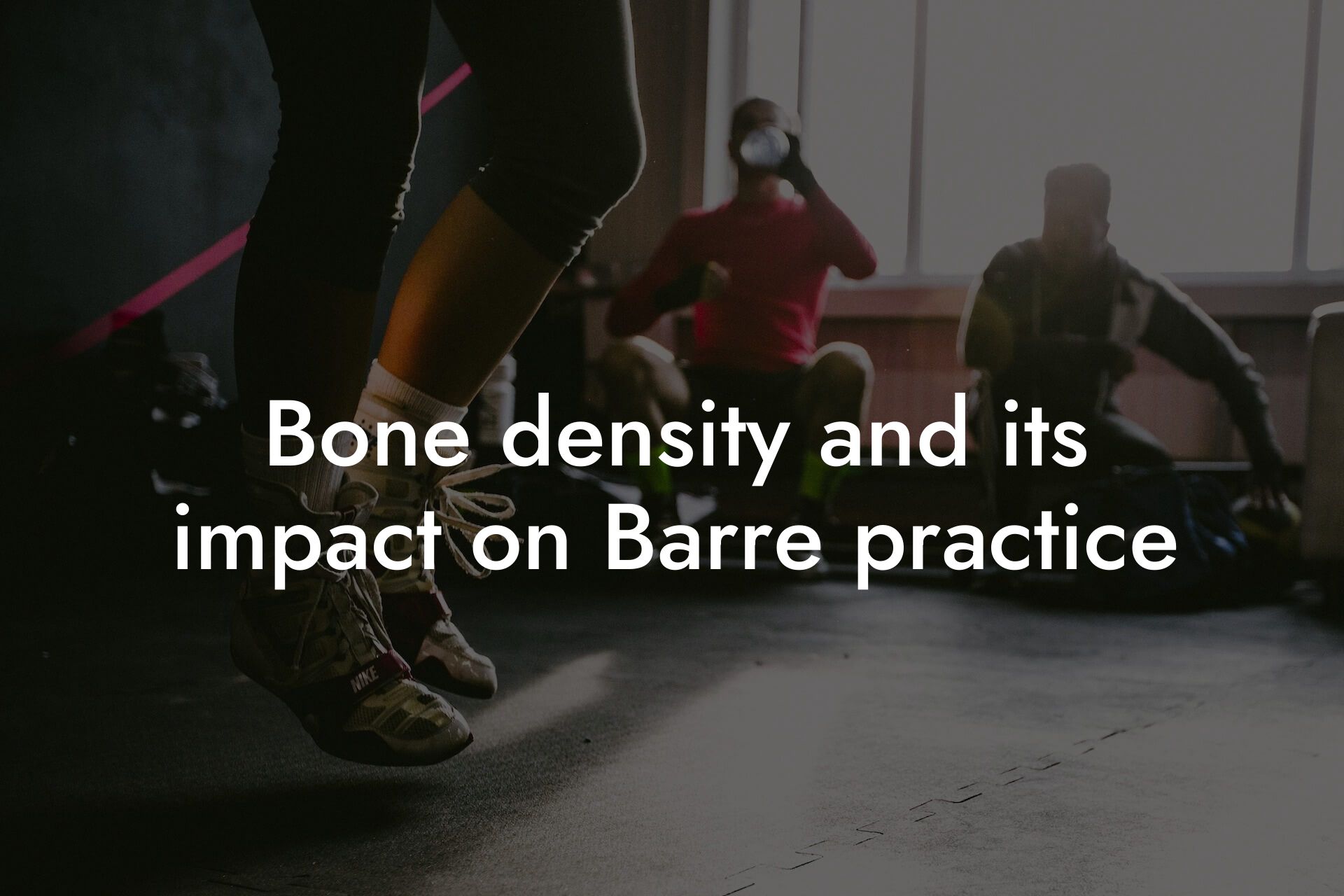As a Barre practitioner, you understand the importance of maintaining a high level of physical fitness and overall well-being. The intense, low-impact movements and isometric holds characteristic of Barre exercises can be challenging on the body, making recovery a crucial aspect of your training regimen. In this article, we'll delve into the importance of recovery strategies for Barre practitioners, providing you with expert advice and actionable tips to optimize your performance, reduce injury risk, and maintain a healthy, strong body.
Table of Contents
- The Importance of Recovery in Barre Training
- Understanding the Different Types of Recovery
- Post-Workout Recovery Strategies for Barre Practitioners
- Nutrition and Hydration for Optimal Recovery
- Sleep and Relaxation Techniques for Barre Practitioners
- Incorporating Rest Days into Your Training Schedule
- Monitoring Progress and Adjusting Your Recovery Strategy
- Frequently Asked Questions
The Importance of Recovery in Barre Training
Barre exercises are designed to engage multiple muscle groups simultaneously, which can lead to increased muscle fatigue and micro-tears in the muscles. If not properly addressed, this can result in decreased performance, increased risk of injury, and prolonged recovery times. A well-structured recovery strategy helps to mitigate these effects, allowing you to maintain a consistent training schedule, improve overall performance, and reduce the risk of chronic injuries.
Understanding the Different Types of Recovery
Recovery is not a one-size-fits-all approach. There are several types of recovery, each serving a unique purpose in the overall recovery process. These include:
Active recovery: Engaging in low-intensity aerobic activities, such as light cardio or yoga, to promote blood flow and facilitate the removal of waste products.
Passive recovery: Engaging in relaxation techniques, such as meditation or deep breathing, to reduce mental and physical stress.
Structural recovery: Focusing on maintaining proper posture, alignment, and movement patterns to reduce the risk of injury and improve overall biomechanics.
Nutritional recovery: Consuming a balanced diet rich in protein, complex carbohydrates, and healthy fats to support muscle repair and growth.
Post-Workout Recovery Strategies for Barre Practitioners
Immediately following a Barre workout, it's essential to focus on active recovery techniques to help reduce muscle soreness and promote relaxation. Try incorporating the following strategies into your post-workout routine:
Stretching: Focus on static stretches that target the major muscle groups engaged during your Barre workout, such as the hamstrings, quadriceps, and glutes.
Foam rolling: Use a foam roller to release tension in the muscles, improve circulation, and reduce muscle soreness.
Self-myofascial release: Utilize tools like lacrosse balls or tennis balls to release tension in the muscles and improve range of motion.
Contrast showers: Alternate between hot and cold water temperatures to reduce inflammation, improve circulation, and promote relaxation.
Nutrition and Hydration for Optimal Recovery
A well-balanced diet is essential for optimal recovery. Focus on consuming a diet rich in:
Protein: Aim to consume 1.2-1.6 grams of protein per kilogram of body weight to support muscle repair and growth.
Complex carbohydrates: Include sources like whole grains, fruits, and vegetables to provide energy and support muscle function.
Healthy fats: Nuts, seeds, and avocados are rich in healthy fats that support hormone production and overall health.
Hydration: Aim to consume at least 8-10 glasses of water per day to help flush out waste products and promote recovery.
Sleep and Relaxation Techniques for Barre Practitioners
Adequate sleep and relaxation are critical components of the recovery process. Aim to get 7-9 hours of sleep per night and incorporate relaxation techniques, such as:
Meditation: Practice mindfulness meditation to reduce mental stress and promote relaxation.
Deep breathing exercises: Focus on slow, controlled breathing to reduce stress and promote relaxation.
Progressive muscle relaxation: Tense and release each major muscle group to reduce muscle tension and promote relaxation.
Incorporating Rest Days into Your Training Schedule
Rest days are an essential component of any training program. By incorporating regular rest days into your schedule, you allow your body time to recover, rebuild, and adapt to the demands of Barre training. Aim to take at least one or two rest days per week, depending on your training intensity and frequency.
Monitoring Progress and Adjusting Your Recovery Strategy
As you incorporate these recovery strategies into your training regimen, it's essential to monitor your progress and adjust your approach as needed. Pay attention to your body, tracking metrics such as:
Performance: Monitor your overall performance, including strength, endurance, and flexibility.
Body composition: Use tools like DEXA scans to track changes in body fat percentage, lean muscle mass, and bone density.
Soreness and fatigue: Pay attention to your levels of muscle soreness and fatigue, adjusting your recovery strategy as needed.
By incorporating these recovery strategies into your Barre training regimen, you'll be able to optimize your performance, reduce injury risk, and maintain a healthy, strong body. Remember to stay patient, consistent, and attentive to your body's needs, and you'll be well on your way to achieving your fitness goals.
Frequently Asked Questions
What are common injuries experienced by Barre practitioners?
As a Barre practitioner, you may be prone to injuries such as shin splints, ankle sprains, knee strains, and lower back pain. These injuries can occur due to overuse, poor form, or inadequate warm-up and cool-down routines. It's essential to listen to your body and take regular breaks to avoid fatigue and prevent injuries.
How can I prevent injuries as a Barre practitioner?
To prevent injuries, focus on proper alignment, engage your core, and maintain controlled movements. Warm up thoroughly before class, and cool down afterwards to reduce muscle soreness. It's also crucial to listen to your body and modify or rest when needed. Additionally, incorporate strengthening exercises for your core, glutes, and legs to improve overall stability and resilience.
What are the benefits of incorporating recovery strategies into my Barre practice?
Incorporating recovery strategies into your Barre practice can help reduce muscle soreness, improve flexibility, and enhance overall performance. Recovery strategies can also help prevent injuries, reduce fatigue, and promote faster recovery between classes. By prioritizing recovery, you can maintain a consistent and effective practice, achieving your fitness goals more efficiently.
What are some effective recovery strategies for Barre practitioners?
Effective recovery strategies for Barre practitioners include foam rolling, stretching, self-myofascial release, and active recovery techniques like cycling or swimming. Additionally, incorporating rest days, compression garments, and proper nutrition can also aid in the recovery process. It's essential to experiment with different techniques to find what works best for your body and practice.
How often should I practice Barre to see optimal results?
The ideal frequency for practicing Barre depends on your individual goals, fitness level, and schedule. Generally, practicing 2-3 times a week can help you see noticeable improvements in flexibility, strength, and overall physique. However, it's essential to balance practice with rest and recovery to avoid burnout and prevent injuries.
Can I practice Barre if I have a pre-existing injury?
If you have a pre-existing injury, it's essential to consult with a healthcare professional or certified Barre instructor before starting a practice. They can help you modify exercises to accommodate your injury and provide guidance on safe and effective practice. Additionally, consider incorporating rehabilitation exercises into your practice to aid in the healing process.
How can I modify Barre exercises to accommodate my physical limitations?
To modify Barre exercises, focus on maintaining proper alignment and engaging your core. Use props like blocks, straps, or a wall to support your body and reduce strain on your joints. You can also reduce the intensity of movements, slow down your pace, or take regular breaks to rest and recover. Consult with a certified instructor for personalized guidance on modifying exercises to suit your needs.
What is the importance of proper warm-up and cool-down routines in Barre?
Proper warm-up and cool-down routines are crucial in Barre to prevent injuries, improve flexibility, and enhance overall performance. A thorough warm-up prepares your muscles for exercise, while a cool-down helps reduce muscle soreness and promote recovery. Incorporate dynamic stretches, cardio exercises, and gentle movements into your warm-up and cool-down routines to optimize your practice.
How can I incorporate stretching into my Barre practice?
Incorporate stretching into your Barre practice by holding static stretches for 20-30 seconds, focusing on major muscle groups like hamstrings, quadriceps, and hip flexors. You can also incorporate dynamic stretches, like leg swings and arm circles, into your warm-up and cool-down routines. Remember to breathe deeply and slowly while stretching to promote relaxation and flexibility.
What is the role of nutrition in recovery for Barre practitioners?
Nutrition plays a critical role in recovery for Barre practitioners. Focus on consuming a balanced diet rich in protein, complex carbohydrates, and healthy fats to aid in muscle repair and recovery. Additionally, stay hydrated by drinking plenty of water before, during, and after practice. Avoid processed foods and sugary drinks that can hinder recovery and overall health.
How can I use compression garments to aid in recovery?
Compression garments can help improve blood flow, reduce muscle soreness, and promote recovery. Wear compression socks, sleeves, or tights during and after practice to enhance the benefits. Look for garments with graduated compression, which provides greater pressure at the extremities to promote blood flow back to the heart.
What is the importance of rest and recovery in a Barre practice?
Rest and recovery are essential components of a Barre practice, allowing your muscles to repair and rebuild. Adequate rest and recovery can help prevent injuries, reduce fatigue, and improve overall performance. Prioritize rest days, take breaks during practice, and incorporate relaxation techniques like meditation and deep breathing to promote recovery.
How can I incorporate active recovery techniques into my Barre practice?
Incorporate active recovery techniques like cycling, swimming, or yoga into your Barre practice to promote gentle movement and relaxation. These activities can help reduce muscle soreness, improve flexibility, and enhance overall recovery. Start with low-intensity activities and gradually increase intensity as your body adapts.
What are some common mistakes Barre practitioners make that can hinder recovery?
Common mistakes Barre practitioners make that can hinder recovery include overexertion, poor form, inadequate warm-up and cool-down routines, and neglecting rest and recovery. Additionally, failing to listen to your body, ignoring injuries, and pushing through pain can also hinder recovery and lead to more severe injuries.
How can I listen to my body and honor its limitations in Barre?
Listen to your body by paying attention to physical sensations, like pain, fatigue, or discomfort. Honor your body's limitations by modifying exercises, taking breaks, or resting when needed. Prioritize self-care, and don't push through pain or discomfort, as this can lead to injuries and hinder recovery.
What is the role of mental recovery in a Barre practice?
Mental recovery is a crucial aspect of a Barre practice, as it can help reduce stress, improve focus, and enhance overall performance. Incorporate relaxation techniques like meditation, deep breathing, and visualization into your practice to promote mental recovery. Prioritize self-care, and take breaks from practice to rest and recharge.
How can I use foam rolling to aid in recovery?
Foam rolling can help reduce muscle soreness, improve circulation, and promote recovery. Use a foam roller to target areas like your IT band, quadriceps, and hamstrings. Roll slowly and gently, focusing on tender areas, and hold for 20-30 seconds to allow for maximum release.
What are some effective self-myofascial release techniques for Barre practitioners?
Effective self-myofascial release techniques for Barre practitioners include using a lacrosse ball or tennis ball to release tension in areas like the shoulders, hips, and glutes. You can also use a foam roller or your own body weight to release tension in areas like the IT band and quadriceps.
How can I incorporate rest days into my Barre practice?
Incorporate rest days into your Barre practice by taking a day off from practice every 7-10 days. Use this time to relax, recharge, and focus on self-care. You can also incorporate active recovery techniques like yoga or gentle stretching on rest days to promote relaxation and flexibility.
What are some signs that I need to take a rest day from Barre?
Signs that you need to take a rest day from Barre include persistent pain or discomfort, fatigue, decreased performance, or mental burnout. If you're experiencing any of these symptoms, take a day off from practice and focus on rest and recovery. Prioritize your body's needs, and don't push through pain or discomfort.
How can I maintain motivation and consistency in my Barre practice?
Maintain motivation and consistency in your Barre practice by setting realistic goals, tracking progress, and celebrating small victories. Find a workout buddy or join a community to stay accountable and motivated. Additionally, incorporate variety into your practice, and try new exercises or classes to avoid plateaus and prevent boredom.
What are some common misconceptions about Barre and recovery?
Common misconceptions about Barre and recovery include the idea that more is better, and that rest and recovery are unnecessary. Another misconception is that Barre is only for dancers or that it's not an effective workout. Debunk these myths by prioritizing recovery, listening to your body, and incorporating variety into your practice.
How can I prioritize recovery in my busy schedule?
Prioritize recovery in your busy schedule by scheduling rest days, incorporating active recovery techniques, and making time for self-care. Use a planner or app to track your practice and schedule, and set reminders to take breaks and rest. Remember, recovery is essential to optimal performance and overall health.
Here are some related articles you might love...
- Maintaining muscle tone and flexibility with Barre
- Using DEXA scans to optimize Barre training
- Bone density and its impact on Barre practice
- How to integrate Barre into a balanced fitness routine
- Nutrition tips for sustained energy in Barre classes
- Reducing body fat for improved Barre results
- Barre for injury prevention and rehabilitation
- The importance of core strength in Barre fitness
- How body composition impacts Barre performance
Zak Faulkner
Zak Faulkner is a leading authority in the realm of physical health and body composition analysis, with over 15 years of experience helping professionals optimise their fitness and well-being. As one the experts behind Tano Performance Group, Zak has dedicated his career to providing in-depth, science-backed insights that empower clients to elevate their physical performance and overall health.
With extensive knowledge of DEXA technology, Zak specializes in delivering comprehensive body assessments that offer precise data on body fat, muscle mass, bone density, and overall physique. His expertise enables individuals to make informed decisions and achieve their fitness goals with accuracy and confidence. Zak’s approach is rooted in a deep understanding of human physiology, combined with a passion for helping clients unlock their full potential through personalised strategies.
Over the years, Zak has earned a reputation for his commitment to excellence, precision, and client-focused service. His guidance is trusted by top professionals who demand the best when it comes to their health. Whether advising on fitness programs, nutritional strategies, or long-term wellness plans, Zak Faulkner’s insights are a valuable resource for anyone serious about taking their health and fitness to the next level.
At Tano Performance Group, Zak continues to lead our Content Team revolutionising how professionals approach their physical health, offering unparalleled expertise that drives real results.




